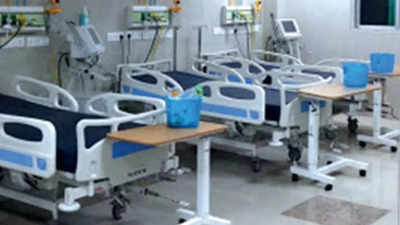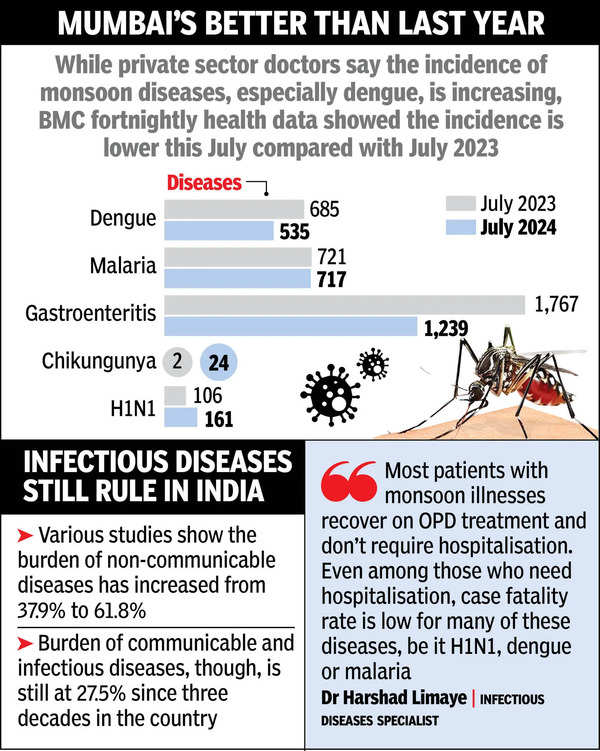[ad_1]

MUMBAI: On July 31, when 30-year-old Andheri resident Babu was wheeled into the casualty of a super-speciality hospital in Juhu, he had a really excessive fever, low blood stress, and his respiratory was erratic. Preliminary scans and fast exams revealed a scary image: His platelet depend was low, he was bleeding into his lungs, he had acute respiratory misery syndrome in addition to jaundice, and his kidneys have been non-functional.
Within the subsequent two hours, the docs at Nanavati Hospital, Juhu, had a analysis that Babu or his household hadn’t heard within the nursing house he had spent three days earlier than transferring right here: Leptospirosis.

Leptospirosis is a bacterial an infection that one will get after wading by way of flood water contaminated with the urine of an contaminated animal. Like gastroenteritis or malaria, it’s one of many monsoon maladies that normally will get resolved with medicines given by the neighbourhood physician. Nonetheless, in a small proportion of sufferers resembling Babu, rain-related illnesses wreak havoc and wish ICU admissions, costing between Rs 15,000 and Rs 25,000 or extra per day relying on the depth of remedy and the hospital’s tackle.
“It’s not solely the cash, the complete household goes by way of emotional trauma as they look forward to some excellent news,” stated senior marketing consultant Dr Pratit Samdani, who asks folks to watch out throughout monsoon as a result of he has had sufferers within the final month whose viral an infection metamorphosed into pneumonia in three days. Furthermore, he added, “bugs are stronger than medication”.
In Babu’s case, although, in response to his treating physician Dr Harshad Limaye, there was a 90% danger of mortality given the severity of his leptospirosis an infection. “He pulled by way of very properly as a result of he’s younger,” stated the infectious illnesses specialist. Babu was strapped to a ventilator for greater than 5 days, needed to bear common dialysis, take platelet in addition to blood transfusions together with potent medicines within the intensive care unit. On Friday, 10 days after he entered the ICU, he was wheeled right into a basic room the place he’s more likely to keep for an additional week. “His kidneys could take one other couple of months to heal so he must proceed with dialysis,” stated Dr Limaye.

Roughly 25km away from Babu’s hospital mattress, a road hawker’s teenage son took him to Fortis Hospital in Mulund as he was fearful about his father’s “excessive weak point”. His father’s diarrheal bout had began roughly 24 hours again on July 30 and not one of the oral medicines had labored. Infectious illnesses specialist Dr Anita Mathew, who inspected the hawker, determined it was most necessary to know the pathogen that had broken his kidneys and wasn’t exhibiting indicators of stopping. “We determined to do a biofire check (a fast PCR-based panel check for a number of pathogens) and came upon in a number of hours that he had cholera,” stated Dr Mathew. He was began on the cholera remedy of doxycycline, however wanted ICU keep for dehydration and kidneys. “He recovered properly and was discharged after per week’s keep,” stated Dr Mathew.
BMC’s fortnightly well being information confirmed an increase in dengue and malaria in late July. Senior marketing consultant Dr Gautam Bhansali concurred, stating sufferers with dengue, H1N1 and different flu wanted hospitalisation due to their excessive temperatures and respiratory signs. Take into account Cuffe Parade resident Pravin Shah, who got here to Bombay Hospital with excessive fever and cough. “I’m susceptible to extreme chest infections and my cough was so violent that Dr Bhansali advised I get admitted for higher administration,” stated Shah who examined constructive for H1N1-flu.
One other household that needed to shell out a invoice of Rs 2.5 lakh for his or her affected person’s one-week keep in a south Mumbai hospital stated they have been simply relieved. When it comes to mortality, monsoon illnesses rank a lot decrease than non-communicable illnesses resembling coronary heart illnesses and hypertension that account for many of the annual deaths within the nation. However monsoon maladies pose an enormous public well being danger as a result of, as intensivist Dr Rahul Pandit from H N Hospital, Girgaum, places it: “We see an enormous proportion of sufferers in three brief months. From the second week of June to Sept, we see a blended bag of issues, from dengue to malaria.”
[ad_2]
This Submit could comprise copywrite


